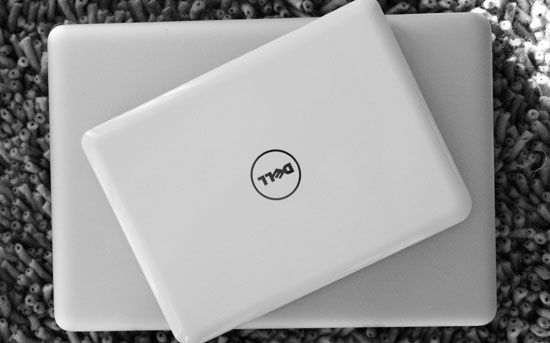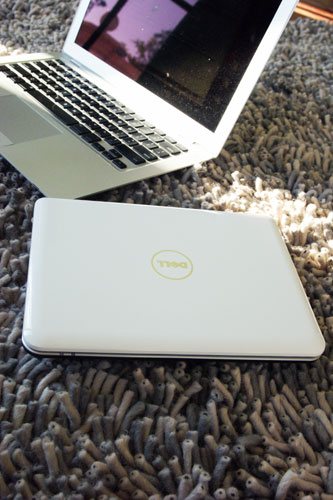Dell Inspiron Mini 9 Reviewed: Refining the Netbook Market
by Anand Lal Shimpi on September 4, 2008 12:00 AM EST- Posted in
- Laptops
Expansion: More than a MacBook Air
Even today, whenever I pull out my MacBook Air I still get people amazed at how small it is, but it's the thinness that gets them - the footprint of the notebook is no different than your standard MacBook. Hold a netbook up to it and the MacBook Air starts to look rather large:

Apple MacBook Air (on bottom) vs. Dell Inspiron Mini 9 (on top)
You give up the thin profile of the Air, but you get something that's more comfortable to carry around (despite being more of a pain to type on). A side effect of the thicker chassis is that there's actually room for some expansion on the Mini. You get three USB ports, a 4-in-1 card reader (SD/SDHC/MMC/MS), VGA out and built in 10/100 Ethernet.

Unfortunately there's no room for an optical drive, and while Dell offers an external one you're better off saving the money and using the network or USB drives to get data on/off the machine. The hardware is fast enough to watch DVDs, but there's no hardware H.264 acceleration so most high resolution/high bitrate HD content (720p/1080p) is out of the question.
Below is a quick spec comparison between the Eee PC 901 and the Inspiron Mini, as well as the MacBook Air just for kicks.
| ASUS Eee PC 901 | Dell Inspiron Mini 9 | MacBook Air | |
| Dimensions | H: 1.5" W: 8.9" D: 6.9" | H: 1.07 - 1.25" W: 9.13" D: 6.77" | H: 0.16-0.76" W: 12.8" D: 8.94" |
| Weight | 2.5 lbs | 2.28 lbs | 3.0 lbs |
| Screen Size/Resolution | 8.9" / 1024 x 600 | 8.9" / 1024 x 600 | 13.3" / 1280 x 800 |
| CPU | Intel Atom N270 - 1.6GHz (45nm Diamondville) | Intel Atom N270 - 1.6GHz (45nm Diamondville) | Intel Core 2 Duo 1.6 - 1.8GHz (65nm Merom) |
| GPU | Intel GMA 950 | Intel GMA 950 | Intel GMA X3100 (144MB UMA) |
| Memory | 1GB or 2GB DDR2-533 | 512MB or 1GB DDR2-533 | 2GB DDR2-667 (fixed) |
| HDD | 4GB on board SSD + 8GB (XP) or 16GB (Linux) removable SSD | 4GB (Linux only), 8GB or 16GB SSD | 80GB 1.8" HDD or 64GB 1.8" SSD |
| Optical Drive | Optional External USB | Optional External USB | Optional External USB SuperDrive |
| Networking | 802.11b/g/n 10/100 Ethernet | 802.11b/g 10/100 Ethernet | 802.11a/b/g/n |
| Built in Camera | Yes | Optional | Yes |
| Battery | 48WHr | 32WHr | 37WHr |
| Price | $599 | $349 | $1799 |










55 Comments
View All Comments
rowcroft - Thursday, September 4, 2008 - link
I have an Acer Aspire 1 - $349 for the 120GB HDD, XP (need it for WWAN card), 1GB RAM, but no bluetooth.Still, I think it's a much more compelling offer than either this or the Asus and suggest you get one to evaluate.
strikeback03 - Thursday, September 4, 2008 - link
I think that picture at the bottom of the first page shows why I hate glossy screens.What I am waiting for is someone to come out with a device that falls somewhere between an Epson P5000 and an Archos 5" internet tablet. Run a real OS, have a decent sized hard drive for music and photo downloads, multiple card readers, touchscreen, and the ability to go on the internet occasionally if it is around. Closest netbook is the Wind or possibly the Lenovo it would seem, but I wouldn't plan on typing enough to need a real keyboard.
prophet001 - Thursday, September 4, 2008 - link
seriously, 118 wpm? how in the world did you get that fast? i've been typing everyday for 6 years and I can't type that fast. Any tips?preslove - Thursday, September 4, 2008 - link
I'm torn now between betting the Dell Mini 9 or the EEE pc 1000H. There really isn't any reason to buy EEE 901, since it is more expensive than the 1000H, which is $549.99, and is only .8 pounds lighter. The 1000H has a much roomier keyboard that is supposedly closer to a "real" notebook's keyboard than a netbook.Two major advantages of the 1000H over the Dell, though, are that it comes with an 80 gig hd and a 6 cell battery. Also it comes with 1 gig of Ram standard.
Adding all the options to the Dell, Win XP, ram upgrade, camera upgrade, and bluetooh and it adds up to $494. That's $65 less than the 1000H, which has a better keyboard and a good sized hard drive, but is about a pound heavier.
I wish these two were in stores so I could compare the weight and keyboards, as that would probably help be choose.
One question: Can the Mini accept a 2 gig stick of Ram?
tayhimself - Thursday, September 4, 2008 - link
Yes 2 GB RAM interest here too. The Acer Aspire looks good to me as well.JarredWalton - Thursday, September 4, 2008 - link
10" netbooks actually start to become viable as a full-time laptop... almost. I'm not Ben, but I'm right with him in terms of typing on these things. I draw the line of comfort at 13.3" notebooks. Predictive typing would help some, but with the width of my shoulders I still end up feeling cramped on anything smaller. (Why can't I get a natural keyboard on a laptop? LOL)However, the above said, 10" is still small and I think too many people are looking at these as a full notebook/desktop replacement rather than a mobile device that supplements regular computer use. 2GB RAM and 80GB HDDs... and then next we'll need faster CPUs and discrete GPUs, and an optical drive, and.... It's a slippery slope, and I think you should either get a real notebook (13.3" or larger - or 12.1" if you don't mind the smaller keyboards) or understand that the netbook is not supposed to be a full notebook and use it as intended. For $350, the Dell Mini looks extremely promising.
n0nsense - Thursday, September 4, 2008 - link
I think the perfect one should be:1. Little bit more powerful processor (Atom dual core or AMD X2)
2. More advanced chipset (less heat more graphics performance and output options) which will allow playback of 1080p on TV.
3. Normal 2.5" HDD/SDD options for upgrade.
4. I would like touchscreen (multi touch is even better)
The rest i think is very close to be perfect.
The reason is for all this more performance is:
Try to listen to some last.fm radio on the web + some fullscreen flash web page or game.
And yes, i know, all this "more" will kill more expensive notebooks.
psychobriggsy - Friday, September 5, 2008 - link
1) Yes, a dual-core Atom would be nice, but it is already multi-threaded (whoa, what's up with this text box, it's gone all funky!)1b) AMD (soon will) have a 22W 1.5GHz X2. I don't know how much power it uses when PowerNow! is enabled, but AMD need to get a standard Athlon 64 out first that has PowerNow! ranges starting from 400MHz at very low voltage first. They do have a 15W Athlon 64 coming out soon as well.
2) This is the most important aspect, and where all the Atom netbooks are failing right now. It's almost criminal.
3) Really unimportant, these are mobile companions. Bet Palm feels stupid in cancelling the Foleo, when it turns out that form factor is what people want.
4) That Dell Linux interface would be perfect for touchscreen.
JarredWalton - Friday, September 5, 2008 - link
You do know that Atom N270 is like 1.5W TDP, right? http://download.intel.com/design/processor/datasht...">Reference A 22W 1.5GHz X2 would use over 10X as much power as the N270. The problem right now is the chipset; we need Poulsbo.psychobriggsy - Friday, September 5, 2008 - link
And the multi-threaded Atom is 2.5W, and the 64-bit Atom is 4W, and the dual-core Atom will be 8W.Also Paulsbo will suck, it's designed for MIDs, maybe the netbooks will be okay with it, but barely. It's a 130nm chip so however cool running the process they are using, it's limiting the clock speed of the GPU, and the number of features it can have.
AMD have an 8W Athlon 64 already, and in reviews the platform consumes less power and outperforms Atom - in a desktop scenario.